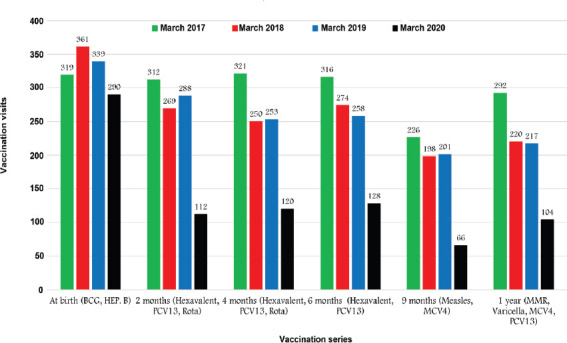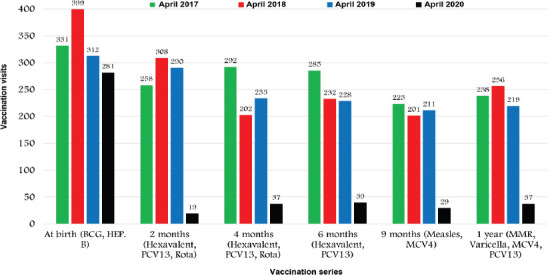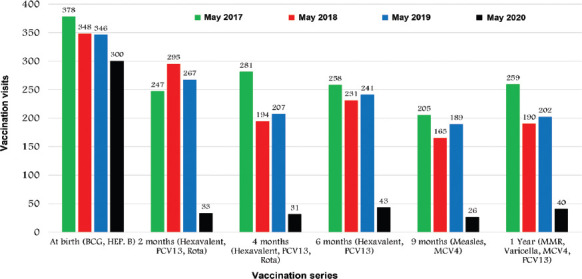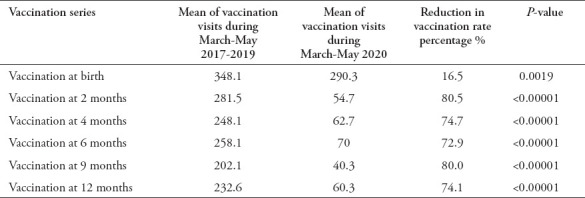Abstract
Objectives:
To investigate whether the coronavirus disease-2019 pandemic has had any effects on pediatric vaccination rates at the main university hospital in Saudi Arabia.
Methods:
A retrospective study conducted at King Saud University Medical City, Riyadh, Saudi Arabia using electronic health records. The vaccination statuses of all children who were scheduled for vaccinations at birth and at 2, 4, 6, 9, and 12 months during March, April and May between 2017 and 2020 were included in the study with total sample of 15,870 children, and comparisons between the cohorts were performed.
Results:
All vaccination visits during April and May 2020 were below the lower extremes except for the birth vaccinations. In March, April, and May 2020 there were respective drops in vaccination visits of 49.93%, 71.90% and 68.48% compared with the mean numbers of vaccination visits during the same months from 2017 to 2019. In comparisons of mean numbers of visits from March 2017 to May 2019 and March to May in 2020, the respective reductions in visits for birth and 2, 4, 6, 9 and 12-month vaccinations were 16.5%, 80.5%, 74.7%, 72.9%, 80.0% and 74.1%.
Conclusions:
The huge impact of the coronavirus disease-2019 pandemic on childhood vaccinations will require urgent vaccination recovery plans with innovative approaches and future action plans to maintain vaccination coverage during any subsequent pandemics.
Keywords: COVID-19, childhood, vaccination
Vaccines have substantially improved health and reduced mortality, particularly among children in low-income countries.1-3 World Health Organization (WHO) launched the Immunization Agenda 2030 strategy in 2020 to accelerate progress towards equitable access and use of vaccines over the new decade.4 However, ensuring everyone has access to immunization services has been challenging, an additional challenge is posed by the COVID-19 pandemic, which has necessitated physical distancing measures to mitigate or delay the epidemic to avoid health-care systems being overwhelmed.5,6 The severe acute respiratory syndrome coronavirus 2 (SARS-CoV-2) emerged in December 2019, when it caused cases of COVID-19 in Wuhan, China. As of August 9, 2020, there were 19,462,112 confirmed cases and 722,285 confirmed deaths across 216 countries and territories.7
On 11 March 2020, the WHO declared an international state of emergency to control the pandemic spread of SARS CoV-2. Strict control measures were implemented ahead of time in Saudi Arabia after the first case of COVID-19 was diagnosed in the country on 02 March 2020.8 The measures to alleviate the pandemic have focused on social distancing and quarantine policies, including stay-at-home orders, working from home, closing schools and mosques, and requiring everyone in the country to avoid gatherings. In the same time a clear messages were sent through the media stress on the availability of all medical service for all whom need it including the routine vaccination.
Pediatric vaccination programs depend on a high level of uptake at specific time and age to achieve a successful reduction in the prevalence and incidence of vaccine-preventable diseases,9 and the above described strict social distancing strategies may result in reduced accessibility of routine immunization services which started to be observed and reported. This may in turn result in children being put at risk of contracting vaccine-preventable diseases, and the associated complications thereof. The present study was conducted to determine whether the current COVID-19 pandemic control measures have affected vaccine coverage rates at the main university hospital in Saudi Arabia.
Methods
The study is a retrospective study conducted after institutional review board approval at King Saud University Medical City (KSUMC Research Project No. E-20-5034), which includes the major teaching hospital in Saudi Arabia. The hospital has a capacity of 1800 beds and an average annual new-born delivery rate of 3800 (range 281-400 per month). All children who were born in KSUMC will be followed up in the well-baby clinic for routine vaccination. The early effects of the COVID-19 pandemic on routine childhood vaccination visits were assessed via electronic health records system (ESIHI), which can retrieves vaccination visits in the well-baby clinic and correlate these visits with the consumption of vaccines from the pharmacy store with vaccine batch number for any child. The data were collected by nurses and physicians. The vaccination statuses of all children who were scheduled for vaccinations at birth and at 2, 4, 6, 9 and 12 months were included in the study because these are considered to be components of the primary vaccination series that prevent serious tuberculosis, hepatitis B, poliomyelitis, rota virus, pertussis, diphtheria, tetanus, Haemophilus influenzae type b, Streptococcus pneumoniae, Neisseria meningitidis, measles, mumps, rubella and varicella. Recommended primary vaccination series in Saudi Arabia: i) Birth, 1st dose of hepatitis B vaccine (HepB) within 2 days of life. ii) Two months old, 2nd dose of HepB, 1st dose of rotavirus vaccine (Rota), 1st dose of diphtheria, tetanus, and acellular pertussis combination vaccine (DTaP), 1st dose of Haemophilus influenzae type b vaccine (Hib), 1st dose of pneumococcal conjugate vaccine (PCV) and 1st dose of inactivated poliovirus vaccine (IPV). iii) Four months old, 3rd dose of HepB, 2nd dose of Rota, 2nd dose of DTaP, 2nd dose of Hib, 2nd dose of PCV and 2nd dose of IPV. iv) Six months old, 4th dose of HepB, 3rd dose of DTaP, 3rd dose of Hib, 3rd dose of PCV, 2nd dose of IPV, 1st dose of oral poliovirus vaccine (OPV) and BCG vaccine. v) Nine months old, 1st dose of quadruple conjugated meningococcus vaccine (MCV4) and 1st dose of measles vaccine. vi) Twelve months old, 1st dose of measles, mumps, rubella vaccine (MMR), 2nd dose of MCV4, 2nd dose of OPV and 4th dose of PCV.
Eighteen-month, 24-month, and school-age immunization series were excluded from the study, as were seasonal vaccines such as those for influenza, and pre-travel vaccines as they are the booster for the primary vaccination series. As the WHO declared COVID 19 as pandemic in March 2020 all children who received the primary vaccination series during March, April, and May between 2017 and 2020 were included in the study, and comparisons between the cohorts during the same period were performed. Data management, calculations and analyses were performed using Microsoft Excel software, bar charts, measures of dispersion, and box, and whisker plots.
Results
A total of 15,870 children were included in the study. The number of vaccination visits during the study months in 2017 was 5,041 (1,786 in March, 1,627 in April, 1,628 in May), followed by 4,593 in 2018 (1,361 in March, 1,338 in April, 1,210 in May), then 4,501 in 2019 (1,556 in March, 1,493 in April, 1,452 in May). The lowest number was 1,735 in 2020 (820 in March, 442 in April, 473 in May).
The mean number of monthly immunization visits during March-May 2017-2020 irrespective of vaccine series was 220.4. The median was 235.5, the upper quartile was 290, the lower quartile was 190, the upper extreme was 399, and the lower extreme was 43. All vaccination visits during April 2020 and May 2020 were below the lower extreme except for birth vaccinations (Figure 1).
Figure 1.

Box and whisker plot representing monthly vaccination visits during March-May 2017-2020.
The mean number of child vaccination visits during the month of March in the years from 2017 to 2019 was 1,638. The total number of child vaccination visits during March 2020 was 820, representing a reduction of 49.93%, p<0.00001 (Figure 2). The mean number of child vaccination visits during the month of April in the years from 2017 to 2019 was 1572.7, and the total number of child vaccination visits during April 2020 was 442, representing a reduction of 71.9%, p<0.00001 (Figure 3).
Figure 2.

Bar chart representing vaccination visits for the primary vaccination series during the month of March from 2017 to 2020. There were substantial drops in the numbers of all types of vaccinations during March 2020 except for birth vaccinations. Hexavalent vaccine includes hepatitis B, diphtheria, tetanus, acellular pertussis, Haemophilus influenzae type b and inactivated poliovirus, MCV4: quadruple conjugated meningococcus vaccine, PCV13: pneumococcal conjugate vaccine, MMR: measles, mumps, rubella
Figure 3.

Bar chart representing vaccination visits for the primary vaccination series during the month of April from 2017 to 2020. There were substantial drops in the numbers of all types of vaccinations during March 2020 except for birth vaccinations. Hexavalent vaccine includes hepatitis B, diphtheria, tetanus, acellular pertussis, Haemophilus influenzae type b and inactivated poliovirus, MCV4: quadruple conjugated meningococcus vaccine, PCV1: pneumococcal conjugate vaccine, MMR: measles, mumps, rubella
The mean number of child vaccination visits during the month of May in the years from 2017 to 2019 was 1,501, and the total number of child vaccination visits during May 2020 was 473, representing a reduction of 68.48%, p<0.00001 (Figure 4).
Figure 4.

Bar chart representing vaccination visits for the primary vaccination series during the month of May from 2017 to 2020. There were substantial drops in the numbers of all types of vaccinations during March 2020 except for birth vaccinations. Hexavalent vaccine includes hepatitis B, diphtheria, tetanus, acellular pertussis, Haemophilus influenzae type b, and inactivated poliovirus, MCV4: quadruple conjugated meningococcus vaccine, PCV13: pneumococcal conjugate vaccine, MMR: measles, mumps, rubella.
The respective mean numbers of visits for birth series and 2, 4, 6, 9 and 12 month vaccinations from March to May during the years from 2017 to 2019 were 348.1, 281.5, 248.1, 258.1, 202.1 and 232.6. The corresponding mean numbers of visits and the differences in means correspond to respective reductions are shown in Table 1.
Table 1.
Comparison between the mean of vaccination visits for all primary vaccination series between March and May 2017-2019 and March-May 2020. A clear drop in the vaccinations rate is noticeable during March-May 2020.

Discussion
The extended vaccination program was initiated in 1979 in Saudi Arabia, and it originally included vaccines for tuberculosis and poliomyelitis, and a combination vaccine for diphtheria, tetanus, and pertussis. It was subsequently expanded to include additional vaccines.10 According to the immunization coverage data published by the Saudi Ministry of Health in 2017 the respective coverage rates for hexavalent (hexavalent vaccine includes hepatitis B, diphtheria, tetanus, acellular pertussis, Haemophilus influenzae type b and inactivated poliovirus) vaccines were 98%, oral poliomyelitis 96%, pneumococcal conjugate 98%, Bacillus Calmette-Guérin (BCG) 97% and measles, mumps, and rubella (MMR) 96%.11 These coverage rates were significantly reduced during the COVID 19 pandemic lockdown.
As the Saudi government continues efforts to prevent community transmission of SARS CoV-2, the disruption of essential health services may occur-including outpatient services. Many providers have transitioned to telemedicine practices where possible, in an effort continue to provide medical homecare. Although some types of pediatric medical consultations can be conducted via telemedicine conferencing, immunization services require an in-person visit.
While the COVID-19 pandemic social distancing strategies have been in place the administration of the standard 2, 4, 6, 9 and 12-month pediatric vaccinations have declined by more than 72.9%. One possible explanation is that COVID-19 directives with regard to staying home overrode the message that the pediatric immunization program would remain operating as usual. It is also possible that parental concerns about potentially exposing their children to SARS-CoV-2 infection during hospital visits contributed to the declines reported herein.12
The decline in birth vaccination coverage during the COVID-19 lockdown regimes was 16.5%. Birth vaccinations are typically administered in a hospital within 24 hours of birth and before discharge, and this explains the huge difference in decline between the birth vaccines and the other standard pediatric vaccines administered at later ages. The decline in March 2020 was 49.9%, which was lower than the declines in April (71.9%) and May (68.5%) 2020. This can be explained by the fact that the social distancing strategies were effectively implemented after the first 10 days of March 2020. The observed declines in vaccination coverage may leave young children and communities vulnerable to vaccine-preventable diseases such as measles. It has been surmised that measles vaccination coverage of 95% is required to establish herd immunity, and if this level of coverage is not maintained measles outbreaks can occur.13
The burden of vaccine-preventable diseases could exert huge pressures on healthcare systems, particularly those that have already been substantially depleted by the COVID-19 pandemic. As well as that, some vaccines such as those for rotavirus are time-dependent and should not be administered after the age of 8 months. The current situation may potentially result in there being a huge number of children for whom rotavirus vaccine becomes contraindicated because they have missed the crucial age-specific window for its administration, and they will subsequently be at high risk of severe gastroenteritis.
Because the physical distancing policies applied in Saudi Arabia amidst the current COVID-19 pandemic differ slightly from one region to the other, the effects of the pandemic and physical distancing measures on vaccination coverage may vary by region. This may occur as a result of differences in disease burdens associated with reductions in healthcare capacity or preventing attendance at healthcare facilities, or behavioral changes (including physical distancing measures), or local initiatives to promote the continuation of vaccination. Strategies to maintain vaccination services for children include segregating different clinics for visitation by sick patients and healthy vaccines, reducing the numbers of patients on site at any given time, closing waiting and registration areas, and having patients register and check in by phone and receive vaccinations from within their vehicles in a car park. Providers can also use electronic health records and immunization information systems to identify children who have missed their scheduled vaccinations, and remind their parents of the vital need to protect their children against serious vaccine-preventable diseases-despite the current COVID-19 pandemic.
The results of the present study are consistent with reports of reduced vaccination rates in other high-income countries including Israel,14 the United States,15,16 and Britain.17 In Karachi Pakistan the mean number of daily immunization visits decreased by 52.8% during the COVID-19 pandemic lockdown compared with baseline.18
In the United States routine pediatric vaccinations decreased after a national emergency was declared on 13 March 2020, but rates of measles vaccination in children aged <2 years have subsequently recovered somewhat.19 This may reflect measures to promote the maintenance of scheduled vaccinations in this age group despite the COVID-19 pandemic, including actively contacting patients whose children are overdue for vaccinations, and changing office workflows to minimize contact between patients. Childhood vaccination coverage in King Saud University Medical City in Saudi Arabia is routinely monitored biannually, but more timely monitoring is required during this unprecedented COVID-19 pandemic.
Study limitation
We consider conducting this study in one center one of the limitations and we encourage a wider study to assess the impact of the COVID-19 pandemic lockdown on the vaccination rate.
In conclusion, herein we have reported the huge impact of the COVID-19 pandemic on childhood vaccinations in Saudi Arabia. Based on our finding and on reports for other countries we think that numerous countries will require urgent vaccination recovery plans and innovative approaches to ensure that adequate pediatric vaccination programs are maintained in the midst of physical distancing requirements. Moreover, continuous and timely assessment of vaccine coverage will be required to respond to potentially volatile changes during the COVID-19 pandemic. Action plans should be formulated to maintain a sufficient level of vaccination coverage to prevent vaccination-preventable diseases and outbreaks during future pandemics.
Acknowledgment
We would like to thank Charlesworth Author Services (https://www.cwauthors.com/) for English language editing.
Footnotes
References
- 1.Andre FE, Booy R, Bock HL, et al. Vaccination greatly reduces disease, disability, death and inequity worldwide. Bull World Health Organ. 2008;86:140–146. doi: 10.2471/BLT.07.040089. [DOI] [PMC free article] [PubMed] [Google Scholar]
- 2.Ozawa S, Mirelman A, Stack ML, Walker DG, Levine OS. Cost-effectiveness and economic benefits of vaccines in low- and middle-income countries:a systematic review. Vaccine. 2012;31:96–108. doi: 10.1016/j.vaccine.2012.10.103. [DOI] [PubMed] [Google Scholar]
- 3.Li X, Mukandavire C, Cucunubá ZM, Abbas K, Clapham HE, Jit M, et al. Estimating the health impact of vaccination against 10 pathogens in 98 low and middle income countries from 2000 to 2030. medRxiv. 2019 Aug 27;:19004358. doi: 10.1016/S0140-6736(20)32657-X. [DOI] [PMC free article] [PubMed] [Google Scholar]
- 4.World Health Organization. Immunization agenda 2030: a global strategy to leave no one behind. cited 2020 April. Available from: https://www.who.int/immunization/immunization_agenda_2030/en/
- 5.Roberton T, Carter ED, Chou VB, Stegmuller A, Jackson BD Y, et al. Early estimates of the indirect effects of the COVID-19 pandemic on maternal and child mortality in low-income and middle-income countries:a modelling study. Lancet Glob Health. 2020;8:e901–e908. doi: 10.1016/S2214-109X(20)30229-1. [DOI] [PMC free article] [PubMed] [Google Scholar]
- 6.Clark A, Jit M, Warren-Gash C, Guthrie B, Wang HHX, Mercer SW, et al. Global, regional, and national estimates of the population at increased risk of severe COVID-19 due to underlying health conditions in 2020: a modelling study. Lancet Glob Health. 2020;8:e1003–e1017. doi: 10.1016/S2214-109X(20)30264-3. [DOI] [PMC free article] [PubMed] [Google Scholar]
- 7.World Health Organization. Coronavirus disease (COVID-19) pandemic [cited 2020] [accessed 2020 August 9]. Available from: https://www.who.int/emergencies/diseases/novel-coronavirus-2019 .
- 8.Alshammari T, Altebainawi A, Alenzi K. Importance of early precautionary actions in avoiding the spread of COVID-19:Saudi Arabia as an Example. Saudi Pharm J. 2020;28:898–902. doi: 10.1016/j.jsps.2020.05.005. [DOI] [PMC free article] [PubMed] [Google Scholar]
- 9.World Health Organization. WHO-UNICEF estimates of DTP3 coverage [cited 2019 July] Available from: https://apps.who.int/immunization_monitoring/globalsummary/timeseries/tswucoveragedtp3.html .
- 10.Alsubaie SS, Gosadi IM, Alsaadi BM, Albacker NB, Bawazir MA, Bin-Daud N, et al. Vaccine hesitancy among Saudi parents and its determinants. Result from the WHO SAGE working group on vaccine hesitancy survey tool. Saudi Med J. 2019;40:1242–1250. doi: 10.15537/smj.2019.12.24653. [DOI] [PMC free article] [PubMed] [Google Scholar]
- 11.Ministry of Health. Annual statistical yearbook [Updated 2017] [Accessed 2019 June 10]. Available from: https://www.moh.gov.sa/en/Ministry/Statistics/book/Documents/ANNUAL-STATISTICAL-BOOK-1438H.pdf .
- 12.Hoffman J Vaccine rates drop dangerously as parents avoid doctor's visits. Update 2020 April 23. Available from: https://www.nytimes.com/2020/04/23/health/coronavirus-measles-vaccines.html .
- 13.Funk S, Knapp JK, Lebo E, Reef SE, Dabbagh AJ, Kretsinger K Jit, et al. Combining serological and contact data to derive target immunity levels for achieving and maintaining measles elimination. BMC Med. 2019;17:180. doi: 10.1186/s12916-019-1413-7. [DOI] [PMC free article] [PubMed] [Google Scholar]
- 14.The Times of Israel. Vaccinations drop amid COVID-19 fears, raising specter of fresh measles outbreak. Update 2020 April 24. Available from: https://www.timesofisrael.com/vaccinations-drop-amid-virus-fears-raising-specter-of-freshmeasles-outbreak/
- 15.Hart C Confessions of a pediatric practice management consultant. The Effect of COVID 19 on immunization rates. updated 2020 April 6. Available from: https://chipsblog.pcc.com/the-effect-of-covid-19-on-immunization-rates .
- 16.Bramer CA, Kimmins LM, Swanson R, Kuo Jeremy, Vranesich P, Jacques-Carroll LA, et al. Decline in child vaccination coverage during the COVID-19 pandemic-Michigan Care Improvement Registry, May 2016-May 2020. MMWR Morb Mortal Wkly Rep. 2020;69:630–631. doi: 10.15585/mmwr.mm6920e1. [DOI] [PubMed] [Google Scholar]
- 17.McDonald HI, Tessier E, White JM, Woodruff M, Knowles C, Bates C, et al. Early impact of the coronavirus disease (COVID 19) pandemic and physical distancing measures on routine childhood vaccinations in England, January to April 2020. Euro Surveill. 2020;25:2000848. doi: 10.2807/1560-7917.ES.2020.25.19.2000848. [DOI] [PMC free article] [PubMed] [Google Scholar]
- 18.Chandir S, Siddiqi DA, Setayesh H, Khan AJ. Impact of COVID-19 lockdown on routine immunisation in Karachi, Pakistan. Lancet Glob Health. 2020 doi: 10.1016/S2214-109X(20)30290-4. S2214-109X (20)30290-4. [DOI] [PMC free article] [PubMed] [Google Scholar]
- 19.Santoli JM, Lindley MC, DeSilva MB, Kharbanda EO, Daley MF, Gallowayet L, et al. Effects of the COVID-19 pandemic on routine pediatric vaccine ordering and administration - United States 2020. MMWR Morb Mortal Wkly Rep. 2020;69:591–593. doi: 10.15585/mmwr.mm6919e2. [DOI] [PubMed] [Google Scholar]


